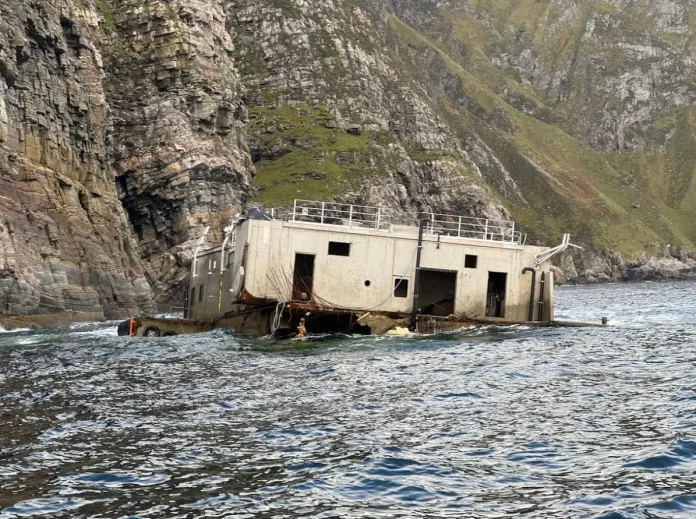An estimated 10,000 liters of diesel from the raft may have leaked into the sea.
On the evening of Tuesday 20 August, a tugboat towing a large feed barge ran aground on the way to a facility operated by salmon farmer Masoval.
All five people involved in the incident—four from the tugboat and one on the raft—were safely rescued.
The following morning, authorities reported the feed raft had sunk. However, it has since emerged that the structure remains grounded and visible, according to the Norwegian Coastal Administration.
The feed raft is a substantial concrete structure, measuring 40 by 20 meters, standing 8–9 meters high, and weighing approximately 2,100 tonnes. It now rests in shallow waters, between four and seven meters deep, close to the shore near the site of the accident, according to Thor Dagfinn Pedersen of the Norwegian Coastal Administration.
“The feed raft has remained stationary since the grounding, as far as we can tell,” Pedersen said.
Pedersen, who leads the Norwegian Coastal Administration’s specialist group for vessel incidents, told Norwegian newspaper BT that while the feed raft no longer poses an immediate pollution threat, it represents a significant waste management challenge. “One way or another, it must be removed,” he emphasised.
Diesel spill and uncertain next steps
Fjordenes Tidende first reported the situation regarding the grounded feed raft. Pedersen estimates that around 10,000 liters of diesel from the raft may have leaked into the sea. However, no final decisions have been made about the next steps.
“It’s still unclear whether the Coastal Administration or the local municipality will take charge of the situation. Responsibility for removing the feed raft lies with its owner,” Pedersen said.
Given the area’s exposure to harsh weather conditions, Pedersen expects the removal process will be lengthy. Two options are currently under consideration: either lifting the entire structure out of the water—a major logistical undertaking—or waiting for winter weather to break the raft apart, with debris to be collected later.
“How the removal proceeds depends largely on the weather. The latter option seems the more likely,” Pedersen noted.
The company that owns the feed raft has confirmed to BT that its insurance provider is handling the matter.
Weather and structural risks
Pedersen added that the raft is not secured but remains in place due to its sheer weight. The area is highly exposed to waves and large swells, which continue to be a concern.
The structure has taken on a significant amount of water, rendering it unstable. “It would likely have capsized by now if it weren’t grounded,” Pedersen said. “Our focus is on ensuring its removal is carried out safely and properly.”
The feed raft, a new structure valued at approximately NOK 45 million ($4 million), was en route to a site in Smøla at the time of the accident, NRK has reported.
Stad municipality has declined to comment on the situation, stating that they first need further discussions with the Coastal Administration.
Legal proceedings
The captain of the tugboat has been charged in connection with the incident, with the charges including possible intoxication and improper navigation. A breathalyzer test administered after the accident returned positive, and a blood sample was taken.
Police attorney Kjetil Linge Tomren, the prosecutor in charge, confirmed on Wednesday that the charges remain unchanged under the Ship Safety Act. “There is nothing new to add at this time,” Tomren said. The police are continuing their investigation to determine whether the cause of the accident was due to technical or human error, or a combination of both.
“The captain has not yet been questioned,” Tomren added.


